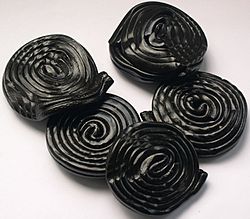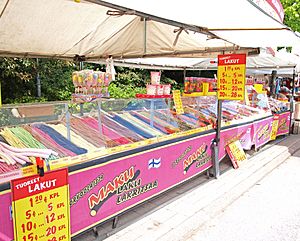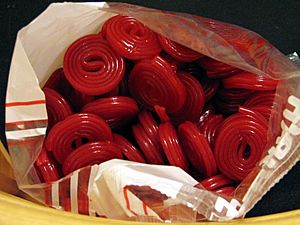Liquorice (confectionery) facts for kids

Liquorice wheels
|
|
| Alternative names | Black liquorice |
|---|---|
| Type | Confectionery |
| Main ingredients | Extract of the roots of the liquorice plant, sugar, binding agent (starch, flour, gum arabic, or gelatin) |
Liquorice (called liquorice in British English and licorice in American English) is a sweet treat. It usually gets its black color and flavor from the roots of the liquorice plant, called Glycyrrhiza glabra. Many different kinds of liquorice sweets are made all over the world.
In North America, "black liquorice" is different from other chewy candies that look similar but don't have real liquorice extract. These often come as ropes or tubes. Black liquorice flavor, sometimes with anise extract, is also found in other candies like jellybeans. In the United Kingdom, you can find sweets like liquorice allsorts. Some liquorice from the Netherlands and Nordic countries tastes salty. This is because it uses ammonium chloride instead of regular salt.
The main things in black liquorice candy are liquorice extract, sugar, and something to hold it all together. This binder is usually starch or flour, gum arabic, gelatin, or a mix of these. Other ingredients can include extra flavors, beeswax to make it shiny, and molasses. Salty liquorice often has more ammonium chloride, sometimes up to 8%. Even regular liquorice can have a little (up to 2%), but you don't taste it as much because of all the sugar. Some liquorice candy uses anise oil for flavor, either instead of or along with liquorice root extract.
Contents
How Liquorice Candy Is Made

Making liquorice candy starts by mixing the ingredients in water. This mixture is then heated to about 135 degrees Celsius (275°F). To get the candy into fun shapes, the hot liquid is poured into molds. These molds are made by pressing shapes into a tray filled with starch powder.
After the liquid is poured, it needs to dry. Once the candies are solid, they are sprayed with beeswax. This makes their surface smooth and shiny.
Health Facts About Liquorice
The extract from liquorice roots contains a natural sweetener called glycyrrhizin. This sweetener is more than 50 times sweeter than regular sugar! Glycyrrhizin also has some special properties. It can help you cough up mucus from your lungs. It can also make your blood pressure go up.
Eating a lot of liquorice every day, like 50 grams (about two ounces) or more, for a couple of weeks can cause changes in your body. Glycyrrhizin can make the amount of potassium in your body drop. This can lead to feeling tired or having some swelling. It's important to eat liquorice in moderation.
Liquorice has been used in herbal medicine for a long time. For example, it can act as a mild laxative.
Some people notice that eating black liquorice can make their stools look green. This is usually because of the blue food coloring that many candy makers use, not the liquorice itself.
Long ago, Alexander the Great gave his soldiers liquorice root to chew. He did this because it helped quench their thirst while they were marching.
Eating too much black liquorice can be very unhealthy. It can cause serious problems with your body's balance of chemicals. It's always best to enjoy candy, including liquorice, in small amounts.
Red Liquorice (Not Really Liquorice!)
In many countries, you might see something called "red liquorice" or "red licorice." This candy looks like liquorice strings, but it doesn't taste like liquorice at all! It's made with other main flavors like strawberry, cherry, raspberry, or cinnamon.
More recently, you can find similar chewy candies in many other colors and flavors, such as apple, mango, blackcurrant, and watermelon.
Even though it's called "red liquorice," it doesn't have the real liquorice taste. The word "black" in "black liquorice" became common in North America to help people tell the difference between the real thing and these fruit-flavored versions.
Popular Types of Liquorice Candy
- Choo Choo Bar
- Crows
- Good & Plenty
- Liquorice allsorts
- London drops
- Vigroids
- Pontefract cake
- Sugarelly, a liquorice drink
- Salty liquorice (also called Salmiak liquorice, very popular in Finland)
- Turkish pepper
- Negro (candy)
- Twizzlers, the original ones from 1845
See also
 In Spanish: Gominola de regaliz para niños
In Spanish: Gominola de regaliz para niños



